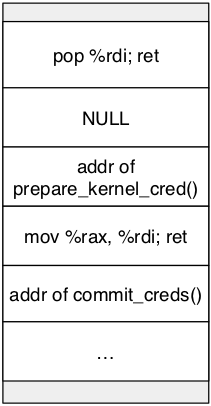纠结了很久,决定还是开启这个模块的学习,在这个路口迷茫了很久了,一直没有决定好走向何处。虽然有可能会走错路,可能会学习很多看起来没用的东西,但希望Kernel的学习能够带我刚开始接触PWN时的乐趣。将会主要借助CTF wiki和《从0到1》
前置
内核会通过进程的 task_struct 结构体中的 cred 指针来索引 cred 结构体,然后根据 cred 的内容来判断一个进程拥有的权限,如果 cred 结构体成员中的 uid-fsgid 都为 0,那一般就会认为进程具有 root 权限。
1 | struct cred { |
因此,很自然就能想到两种思路来进行提权:
- 直接修改
cred结构体的内容 - 修改
task_struct结构体中的 cred 指针指向一个满足要求的 cred
直接定位
cred 结构体的最前面记录了各种 id 信息,对于一个普通的进程而言,uid-fsgid 都是执行进程的用户的身份。因此我们可以通过扫描内存来定位 cred。
1 | struct cred { |
在实际定位的过程中,我们可能会发现很多满足要求的 cred,这主要是因为 cred 结构体可能会被拷贝、释放。一个很直观的想法是在定位的过程中,利用 usage 不为 0 来筛除掉一些 cred,但仍然会发现一些 usage 为 0 的 cred。这是因为 cred 从 usage 为 0, 到释放有一定的时间。此外,cred 是使用 rcu 延迟释放的。
间接定位
task_struct
进程的 task_struct 结构体中会存放指向 cred 的指针,因此我们可以
- 定位当前进程
task_struct结构体的地址 - 根据 cred 指针相对于 task_struct 结构体的偏移计算得出
cred指针存储的地址 - 获取
cred具体的地址
comm
comm 用来标记可执行文件的名字,位于进程的 task_struct 结构体中。我们可以发现 comm 其实在 cred 的正下方,所以我们也可以先定位 comm ,然后定位 cred 的地址。
1 | /* Process credentials: */ |
然而,在进程名字并不特殊的情况下,内核中可能会有多个同样的字符串,这会影响搜索的正确性与效率。因此,我们可以使用 prctl 设置进程的 comm 为一个特殊的字符串,然后再开始定位 comm。
修改
在这种方法下,我们可以直接将 cred 中的 uid-fsgid 都修改为 0。当然修改的方式有很多种,比如说
- 在我们具有任意地址读写后,可以直接修改 cred。
- 在我们可以 ROP 执行代码后,可以利用 ROP gadget 修改 cred。
利用UAF修改
如果我们在进程初始化时能控制 cred 结构体的位置,并且我们可以在初始化后修改该部分的内容,那么我们就可以很容易地达到提权的目的。这里给出一个典型的例子
- 申请一块与 cred 结构体大小一样的堆块
- 释放该堆块
- fork 出新进程,恰好使用刚刚释放的堆块
- 此时,修改 cred 结构体特定内存,从而提权
非常有意思的是,在这个过程中,我们不需要任何的信息泄露。
利用commit_creds修改
我们还可以使用 commit_creds(prepare_kernel_cred(0)) 来进行提权,该方式会自动生成一个合法的 cred,并定位当前线程的 task_struct 的位置,然后修改它的 cred 为新的 cred。该方式比较适用于控制程序执行流后使用。
